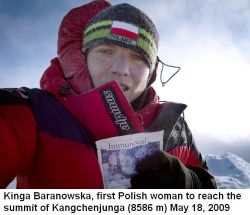In the Beginning
The project started a couple of years ago after the 1999 and 2001 Mallory/Irvine Expeditions on the big mountain set out to try and locate the bodies of the two climbers and see whether any evidence could be found of summit success. It was known that they were carrying a camera and the frozen conditions might have preserved the film.
George Mallory's body was famously located in 1999 and his possessions returned to his relatives. They wanted to pass on the mountaineering items to a heritage association, but nothing existed; Mary Rose picked up on the void and became involved. Fortunately the BMC had plans to open a museum and the items have now become the centre piece of the National Mountaineering Museum's displays.
Mary Rose was fascinated by the whole business and set about finding funding for an investigative project. The first stage was to document the items of clothing found on Mallory's body and to cross check with the Expedition Report to ascertain whether an answer could be found to the 75 year-old clothing debate - were the climbers were warm enough to be able to survive a summit attempt? Did their clothing offer enough flexibility to allow them to climb the obstacles on the route.
There were some fragments of clothing left on the body and these were tested through Southampton University's Textile Conservation Centre at Winchester and the normal mountaineering test labs at the University of Leeds. These gave crucial insights into the seven layers of thin natural fibre clothing worn. It had been calculated that the garments worn had a tog value of 3.5 togs.
Over the last year similar fabric and construction methods were researched so that a set of garments could be made up almost identical to the original items - not an easy job as patterns have changed, materials developed and construction methods improved.
As a reference point, Mary's Rose's husband - who is the same size as Mallory - and Alan Hinkes donned ancient and modern high altitude clothing side by side. Hinkes noticed how close fitting the 1924 replica garments were compared to his bulky modern suit plus the absence of zips - only just been invented in the 1920s - which must have made toilet breaks significantly more fiddly.
Side By Side
Alan's modern clothing weighed 4.825 kg compared to just 4.160 kg for the Mallory replicas, and the 1920s garments also offered better movement as the layers slid easily over each other.

(C)OUTDOORSmagic
The making of the Replicas
The team was headed up by Vanessa Anderson (a student on Derby Uni's MA) and Joyce Meader who took us through the up to seven layers worn: essentially silk, wool, silk, wool and finishing with an outer layer of Burberry cotton gabardine, with the hassles of sourcing the products.
It was interesting to note that elastic was not around then so there was no way to use underwear as it is used nowadays. Also many of the woollen items would have had to be had knitted by the families of the expedition members. It became obvious why Bernard Shaw's take on the outfits used was like 'a Connemara picnic surprised by a snowstorm'.
The boots have still not been investigated properly (any prospective PhD's wanting a subject?), but had novel hob-nails (attached through the 3mm leather sole, but insulated from the feet by a 10mm felt) and were calculated to weigh 0.8kg - compared to the 1953 footwear at 1.2kg, Al Hinkes's at 1.4 kg and Chris Bonington's at 1.8kg.
Three layers of socks worked with three layers of long-johns and military-style puttees. Compare this to the original lightweight boot revolution headed up by the KSB, which weighed in at just over 0.5 kg and it can be surmised how the 1924 initiated the current trend for lightweight outdoor items.
Documents from the 1910 era recorded how Hope and Kirkpatrick alpine summited with 2.8kg packs (that weighed just 0.8kg when empty!). No glove information has been developed and a call to anyone who might be able to shed light on the subject was put out. Another interesting item revealed was a woollen Buff type object (made from the best Merino), that had a multitude of uses ranging from head gear to kidney warmers.
Conclusions - It Was Possible
The conclusion was drawn that Mallory and Irvine had the correct clothing to enable them to survive at that altitude, plus the ability to climb easily while wearing it all.
They were also working in conjunction with the clothing and with the levels of fitness that allowed them to reach that altitude, would theoretically have been able to successfully summit the world's highest mountain.
* Source: OUTDOORSmagic
* zapraszam do subskrypcji mojego bloga :










































mallory's attempt to the everest on e of the most daring contributions to the royal geographical society. i'm a firm believer of the fact that mallory and irvine were the first one to reach everest but haven't received acknowledgement of the fact